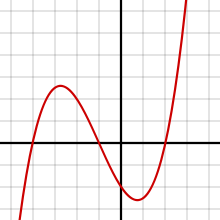- Differentiable function
-
 The absolute value function is not differentiable at x = 0.
The absolute value function is not differentiable at x = 0.
In calculus (a branch of mathematics), a differentiable function is a function whose derivative exists at each point in its domain. The graph of a differentiable function must have a non-vertical tangent line at each point in its domain. As a result, the graph of a differentiable function must be relatively smooth, and cannot contain any breaks, bends, or cusps, or any points with a vertical tangent.
More generally, if x0 is a point in the domain of a function ƒ, then ƒ is said to be differentiable at x0 if the derivative ƒ′(x0) is defined. This means that the graph of ƒ has a non-vertical tangent line at the point (x0, ƒ(x0)), and therefore cannot have a break, bend, or cusp at this point.
Contents
Differentiability and continuity
 The Weierstrass function is continuous, but is not differentiable at any point.
The Weierstrass function is continuous, but is not differentiable at any point.
If ƒ is differentiable at a point x0, then ƒ must also be continuous at x0. In particular, any differentiable function must be continuous at every point in its domain. The converse does not hold: a continuous function need not be differentiable. For example, a function with a bend, cusp, or vertical tangent may be continuous, but fails to be differentiable at the location of the anomaly.
Most functions which occur in practice have derivatives at all points or at almost every point. However, a result of Stefan Banach states that the set of functions which have a derivative at some point is a meager set in the space of all continuous functions.[1] Informally, this means that differentiable functions are very atypical among continuous functions. The first known example of a function that is continuous everywhere but differentiable nowhere is the Weierstrass function.
Differentiability classes
Main article: Smooth functionA function ƒ is said to be continuously differentiable if the derivative ƒ′(x) exists, and is itself a continuous function. Though the derivative of a differentiable function never has a jump discontinuity, it is possible for the derivative to have an essential discontinuity. For example, the function
is differentiable at 0 (with the derivative being 0), but the derivative is not continuous at this point.
Sometimes continuously differentiable functions are said to be of class C1. A function is of class C2 if the first and second derivative of the function both exist and are continuous. More generally, a function is said to be of class Ck if the first k derivatives ƒ′(x), ƒ″(x), ..., ƒ(k)(x) all exist and are continuous.
Differentiability in higher dimensions
See also: Multivariable calculusA function f: Rm → Rn is said to be differentiable at a point x0 if there exists a linear map J: Rm → Rn such that
If a function is differentiable at x0, then all of the partial derivatives must exist at x0, in which case the linear map J is given by the Jacobian matrix.
Note that existence of the partial derivatives (or even all of the directional derivatives) does not guarantee that a function is differentiable at a point. For example, the function ƒ: R2 → R defined by
is not differentiable at (0, 0), but all of the partial derivatives and directional derivatives exist at this point. For a continuous example, the function
is not differentiable at (0, 0), but again all of the partial derivatives and directional derivatives exist.
It is known that if the partial derivatives of a function all exist and are continuous in a neighborhood of a point, then the function must be differentiable at that point, and is in fact of class C1.
Differentiability in complex analysis
Main article: Holomorphic functionIn complex analysis, any function that is complex-differentiable in a neighborhood of a point is called holomorphic. Such a function is necessarily infinitely differentiable, and in fact analytic.
Differentiable functions on manifolds
If M is a differentiable manifold, a real or complex-valued function ƒ on M is said to be differentiable at a point p if it is differentiable with respect to some (or any) coordinate chart defined around p. More generally, if M and N are differentiable manifolds, a function ƒ: M → N is said to be differentiable at a point p if it is differentiable with respect to some (or any) coordinate charts defined around p and ƒ(p).
See also
References
- ^ Banach, S. (1931). "Uber die Baire'sche Kategorie gewisser Funktionenmengen". Studia. Math. (3): 174–179.. Cited by Hewitt, E and Stromberg, K (1963). Real and abstract analysis. Springer-Verlag. Theorem 17.8.
Categories:- Differential calculus
- Mathematical analysis
- Types of functions
Wikimedia Foundation. 2010.





